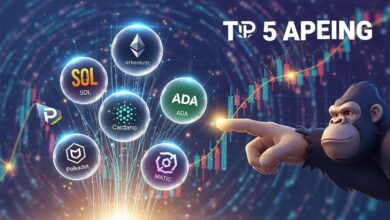Altcoin Market Breakout Looms as Bitcoin Dominance Weakens
Is an altseason near? With Bitcoin dominance slipping, altcoins eye a breakout. See key signals, strategies, and risks before the rotation accelerates.

The crypto market is entering a pivotal phase where attention is drifting away from Bitcoin’s gravity and toward the broader universe of alternative assets. Traders and investors are watching for a decisive turn: a period in which altcoins begin to outperform as Bitcoin dominance eases off recent peaks. This transition—often dubbed altseason—doesn’t happen overnight. It is a process shaped by macro liquidity, sentiment, narratives, on-chain metrics, and how capital rotates across the crypto market cap spectrum.
When Bitcoin dominance climbs, it signals risk concentration in the most established asset. When it stalls or reverses, liquidity can begin to seep into Ethereum, Solana, Layer-2 scaling ecosystems, DeFi, NFTs, and emerging narratives like real-world assets (RWAs) and Depin. Altcoin Market Breakout. The early innings of an altcoin breakout often look deceptively quiet: modest relative strength in a handful of names, creeping improvements in market breadth, and a rise in developer and user traction long before price charts explode higher.
This in-depth guide explains what weakening Bitcoin dominance implies, how to read the technical analysis and fundamental analysis signals that matter, what narratives could drive the next leg, and how to position with robust risk management. The goal isn’t to over-optimize for keywords or hype, but to give you a practical playbook for navigating a market where opportunity can appear—and disappear—quickly.
What Bitcoin Dominance Signals for Altcoins
Bitcoin dominance (often tracked as BTC.D) measures Bitcoin’s share of total crypto market cap. As this metric rises, it reflects capital seeking safety or a strong Bitcoin-led uptrend. When BTC.D stalls or falls, it can herald a liquidity rotation into smaller assets. Understanding this dynamic is essential when evaluating whether an Altcoin Market Breakout is brewing.
BTC.D and its feedback loops
At its core, BTC.D is a sentiment barometer. Rising dominance suggests investors prefer lower volatility and deeper liquidity, gravitating to Bitcoin’s brand and infrastructure. Weakening dominance implies more risk tolerance: traders and longer-term allocators start venturing down the market-cap ladder in search of alpha. A decline in BTC.D can create feedback loops. As altcoins rally, their market caps increase, mechanically pressing dominance lower, which draws more eyes to the move, further accelerating the rotation.
Historical patterns and their caveats
Historically, pronounced Bitcoin rallies often precede altcoin surges by weeks or months. First, Bitcoin breaks out and captures headlines; then, once it consolidates, capital explores altcoin liquidity pockets, especially where tokenomics are favorable and product traction is visible. Yet, every cycle differs. Regulatory updates, macro shifts in rates and liquidity, and idiosyncratic risks—like protocol exploits—can distort the textbook handoff. Treat history as a guide, not a guarantee.
Why Bitcoin dominance weakens near inflection points
BTC.D tends to waver when marginal buyers of Bitcoin slow, while builders and users continue to expand activity across Layer-1 and Layer-2 ecosystems. If stablecoin issuance grows, DeFi yields become competitive, and on-chain activity increases outside Bitcoin’s orbit, dominance often leaks. Altcoin Market Breakout .The effect is magnified if Ethereum breaks key support and resistance zones or if high-throughput networks like Solana show improving market breadth and developer momentum.
The Mechanics of an Altcoin Breakout

An altcoin market breakout isn’t just green candles. It’s a complex sequence where liquidity rotation, breadth, and narratives synchronize.
Liquidity rotation and the role of stablecoins
Liquidity rotation typically starts with stablecoins. When stablecoin market caps expand, dry powder grows. If BTC.D slips while stablecoin supply rises, it can be the mix that fuels breakout conditions. Traders deploy into DeFi pools, fund treasury swaps, and supply market makers, improving order book depth. As spreads tighten, smaller names can run with less slippage, reinforcing the rotation.
Market breadth and relative strength
True breakouts are broad. A few isolated spikes can be liquidity traps; sustainable moves feature expanding advance-decline participation across sectors: Layer-2 scaling, NFTs, RWAs, AI-crypto, gaming, and interoperability. Track relative strength by comparing each asset to Bitcoin or to an altcoin index. Early leaders often set the tone for the sector’s durability and hint at where to allocate during pullbacks.
Catalysts and narratives that push the cycle forward
Narratives channel capital. Upgrades in Ethereum (throughput, fee markets), the rise of restaking, modular blockchains, and surges in Solana ecosystem usage can serve as ignition. DePIN can excite investors with tangible demand. RWAs might unlock institutional flows via compliant yields. Altcoin Market Breakout. Each narrative creates a language of its own, drawing developers, liquidity, and media attention in a loop that can lengthen altseason.
Technical and On-Chain Indicators to Watch
Chart literacy and data literacy reinforce each other. Combining technical analysis with on-chain metrics helps validate whether a weakening in Bitcoin dominance will translate into durable altcoin outperformance.
Total market caps and dominance levels
Many analysts track TOTAL3 (total crypto market cap excluding Bitcoin and Ethereum) for clarity on pure altcoin momentum. A sustained break above prior resistance, accompanied by rising volume, suggests the move is not just noise. Meanwhile, horizontal levels on BTC.D—support and resistance—offer checkpoints. If dominance loses key support while TOTAL3 breaks higher, conviction grows that an altcoin breakout is real.
Funding rates, open interest, and perp premiums
Perpetual futures data—funding rates and open interest—reveal positioning. Moderately positive funding and rising open interest, alongside spot leadership, indicate healthy demand. Excessively positive funding and parabolic open interest hint at over-leverage and vulnerability. Align these with spot flows, not just derivatives, to avoid chasing short-squeezes.
Stablecoin flows and exchange reserves
Watch stablecoin inflows to exchanges and net issuance trends. Rising issuance with steady or declining exchange reserves can mean capital is moving into DeFi or staking, not just ready to sell. Conversely, spiking exchange reserve balances may front-run volatility, both up and down.
Active addresses, TVL, and developer velocity
On-chain activity—active addresses, transactions, and fee revenue—paired with TVL trends in DeFi give texture to price. Protocols adding real users and fees are likelier to sustain gains. Developer velocity—commits, pull requests, and funded grants—supports a thesis that goes beyond short-term speculation.
Fundamental Filters for Picking Altcoins

Outperformance during altseason is uneven. A rigorous filter helps separate durable projects from fickle pumps.
Tokenomics and supply dynamics
Assess tokenomics with clarity. Look at circulating supply versus fully diluted valuation, emissions schedules, and how tokens accrue value. Protocols that share fees with token holders, use tokens for staking or security, or drive consistent demand through utility stand above pure narrative plays. Avoid projects with aggressive unlocks that can cap upside.
Real users and product-market fit
Examine whether a protocol solves a real problem. DeFi platforms offering competitive yields with robust risk controls, Layer-2 scaling solutions materially lowering fees, or DePIN projects with verifiable off-chain demand often sustain momentum. Check daily active users, retention, and growth curves. Authentic demand outlives hype.
Team quality, governance, and roadmap
Transparent teams with a history of shipping, strong governance, and a credible roadmap reduce execution risk. Frequent testnet milestones, third-party audits, and formal verification promote trust. Healthy decentralization and community alignment—visible in governance participation and grant distribution—are additional green flags.
Security posture and audit depth
Security is non-negotiable. Review audit coverage, bug bounty programs, and incident response history. Projects that publish post-mortems and improve processes after incidents deserve attention; those that obscure problems do not.
Strategy: Positioning for a Potential Altseason
Good strategy is less about predictions and more about preparation. If you believe an altcoin market breakout is near as Bitcoin dominance weakens, structure a plan that survives different outcomes.
Portfolio construction and diversification
Build a barbell. On one end, hold high-quality majors like Ethereum and top Layer-1s with proven ecosystems. On the other, allocate to a curated basket of mid-caps and a handful of experimental small-caps that align with your highest-conviction narratives. Keep dry powder in stablecoins for rotation and dips. The mix should reflect your risk tolerance and time horizon.
Entry frameworks and exit discipline
Use staged entries around support and resistance rather than all-in bets. Track relative strength: scale into leaders on constructive pullbacks, not exhausted spikes. Predefine exits with invalidation levels and partial profit targets. The market rewards discipline more than bravado.
Risk management and position sizing
Risk management is your edge. Cap per-position risk as a percentage of portfolio value. Avoid over-leverage; derivative exposure compounds drawdowns in choppy rotations. Use portfolio-level max drawdown rules to force a de-risk if conditions deteriorate. Protecting capital extends your runway to catch the next high-probability setup.
Taxes, compliance, and operational hygiene
Consider tax lots, holding periods, and jurisdictional rules before trading. Keep records of swaps, yields, and fees. On the operational side, prioritize security: hardware wallets, multisig where feasible, phishing-resistant practices, and cautious permissions for DeFi contracts. A few minutes of hygiene can save months of regret.
See More: Best Crypto To Buy Now Bitcoin Steady Altcoins Surge
Narratives to Track in the Next Rotation
Cycles are powered by stories that map to real adoption. The following themes could direct flows if Bitcoin dominance keeps easing.
Ethereum, restaking, and the L2 economy
With Layer-2 scaling maturing, developers deploy apps with lower fees and faster confirmation. Restaking protocols that reuse security and innovative data-availability solutions can amplify the Ethereum economy. Watch for L2s with rising throughput, sticky users, and fee capture models that align with token value.
Solana and high-throughput consumer apps
High-throughput chains like Solana continue to attract consumer-grade apps—payments, gaming, and mobile-first UX. If fees remain low while reliability improves, these ecosystems can incubate viral use cases that pull in non-crypto natives.
Interoperability and modular architectures
Interoperability standards and modular blockchains split the stack: execution, settlement, consensus, and data availability. This unlocks specialized chains while maintaining composability. Track ecosystems that simplify cross-chain UX without sacrificing security.
DePIN and real demand
DePIN connects crypto incentives to physical infrastructure—wireless networks, compute, storage. If token incentives bootstrap networks that later sustain themselves on real demand, you get reflexivity with fundamentals, not just speculation.
RWAs, stablecoin rails, and institution-grade primitives
RWAs funnel traditional yields and credit markets on-chain, while stablecoin rails modernize settlements. If compliance-first platforms scale without compromising decentralization, they can unlock large pools of capital that are otherwise stuck behind legacy rails.
Privacy and compliance balance
A new wave of privacy tools aims to reconcile user protections with regulatory transparency. Teams that strike this balance—privacy for consumers, traceability for bad actors—could become core infrastructure.
Pitfalls and How to Avoid Them
An altseason can be exhilarating and brutal. Avoid the most common mistakes.
Liquidity traps and exit friction
Some tokens move sharply on paper but are impossible to exit at size. Monitor order book depth and slippage before entering. If your model requires a 10% intraday move to break even after fees and slippage, the setup is brittle.
Over-leverage and hidden convexity
Leverage magnifies both gains and losses. Products with embedded leverage—yield optimizers, structured notes, or reflexive staking loops—can carry hidden convexity that detonates in volatile phases. Know your greeks, not just your gains.
Narrative bias and ignoring invalidations
A story can outshine the scoreboard. If price violates your support and resistance levels or on-chain metrics deteriorate, cut the position. Confirmation bias is expensive; humility is cheap.
Security shortcuts and permissions creep
Every wallet connection, approval, and signature is an attack surface. Regularly review token approvals, use allowlists, and segregate hot and cold storage. Keeping your keys safe is part of risk management, not an afterthought.
Outlook: Timelines and Scenarios
No one can timestamp a breakout, but you can map scenarios.
Soft-landing risk-on
If macro conditions remain supportive, stablecoin issuance expands, and TOTAL3 basing resolves upward while BTC.D slips through support, the altcoin market breakout could broaden for weeks or months. Expect rotational leadership: DeFi one week, AI and gaming the next, with Ethereum and Solana acting as liquidity hubs.
Choppy handoff or delayed rotation
If Bitcoin continues to command the spotlight with intermittent spikes, altcoins may see rolling mini-seasons. In this environment, focus on relative strength leaders and avoid laggards. Keep position sizes modest and recycle capital quickly.
What invalidates the altseason thesis
A sharp risk-off shock—macro or regulatory—can pull liquidity back to Bitcoin or into stablecoins, stalling alt outperformance. If BTC.D reclaims broken resistance while TOTAL3 loses key levels on expanding volume, treat it as a strong invalidation and de-risk.
Conclusion
A weakening in Bitcoin dominance does not guarantee an altcoin market breakout, but it often precedes one. The edge comes from preparation: understanding how liquidity rotation works, identifying honest market breadth, respecting on-chain metrics, and applying consistent risk management. Favor projects with sound tokenomics, real users, and shipping teams. Track the right indicators—TOTAL3, BTC.D levels, stablecoin flows, funding and open interest, and developer velocity. Have a plan for entries, exits, and security hygiene. If the handoff from Bitcoin to altcoins gathers steam, you’ll be prepared to participate with discipline rather than emotion.
FAQs
Q: What exactly is Bitcoin dominance, and why does it matter for altcoins?
Bitcoin dominance measures Bitcoin’s share of total crypto market cap. When it falls, it often signals investors are willing to take on more risk, rotating into altcoins. That rotation can lift prices across sectors if supported by broader market breadth, rising stablecoin supply, and healthy on-chain activity outside of Bitcoin.
Q: How do I know an altcoin breakout is real and not just a brief pump?
Look for confirmation across multiple signals: TOTAL3 breaking above resistance on rising volume, BTC.D losing support, improving relative strength in leading sectors, and supportive on-chain metrics such as user growth and TVL expansion. If only a few thinly traded tokens are moving while funding rates spike, you may be seeing a short-lived squeeze.
Q: Which indicators should I monitor daily during a potential altseason?
Track BTC.D and TOTAL3, stablecoin net issuance, perp funding rates and open interest, exchange reserves, and a shortlist of sector leaders for relative strength. Add developer updates and roadmap milestones for projects you hold to ensure the fundamentals align with price action.
Q: What’s the safest way to build exposure to altcoins?
There’s no risk-free route, but you can improve your odds by constructing a barbell portfolio anchored by majors like Ethereum and top Layer-1s, plus a selective set of mid-caps tied to strong narratives. Use staged entries, set invalidations, limit per-position risk, avoid over-leverage, and keep a portion in stablecoins for flexibility.
Q: What could derail an altseason after Bitcoin dominance weakens?
Macro shocks, adverse regulatory surprises, major protocol exploits, or a failure of altcoin fundamentals to translate into real usage can all stall momentum. If BTC.D rebounds above broken resistance while TOTAL3 breaks down, treat it as a strong warning and reduce exposure until conditions improve.



